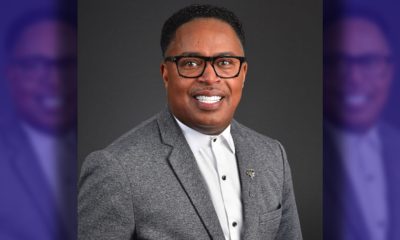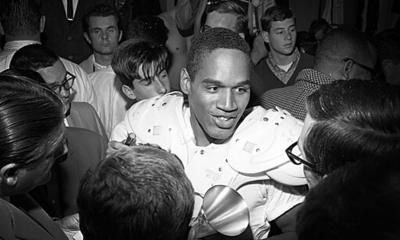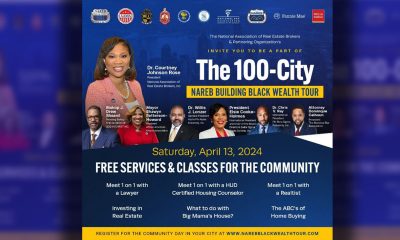National
Nielsen Study: Black Media More ‘Relevant’ to Black Consumers


NNPA Chairman Cloves Campbell speaks as NNPA President and CEO Bill Tompkins (left), Nielsen Senior Vice President Cheryl Pearson-McNeil (center) and Nielsen Vice Chair Susan Whiting (right) await their turn at the podium. (Photo by Roy Lewis for NNPA)
NNPA Editor-in-Chief
WASHINGTON (NNPA) – Companies that fail to advertise with Black media are missing an opportunity to effectively reach nearly 43 million African Americans whose $967 billion annual buying power is projected to exceed $1 trillion in three years, according to the new study released by Nielsen and the National Newspaper Publishers Association (NNPA).
“Still the largest racial minority group in America, with a projected buying power of $1.1 trillion by 2015, Black consumers remain at the forefront of social trends and media consumption,” the study found. The findings were released Friday at the Congressional Black Caucus Foundation Legislative Conference.
“Our collaboration with the NNPA has been successful,” said Susan Whiting, vice chair of Nielsen, a premier global information and measurement company. “NNPA’s insertion of the report into its 200 publications allows Nielsen access to millions of African-American consumers, and allows us to share vital information that will help increase the awareness of Blacks’ consumer power.”
And according to the report, that power is considerable.
“Since 2000, the total U.S. population only increased by 11.3%, while the Black population increased by 17.9%, a rate that is 1.6 times the greater overall growth,” the Nielsen study said. The report noted that the U.S. Black population is larger than 163 of the 195 countries in the world, including Argentina, Poland, Canada and Australia.
“The average income for African-American households nationwide is $47,290 with 35% earning $50,000 or more,” the report stated. Ten percent of Black households earn $100,000 or more each year. The study noted, “The Black population and its aggregate buying power is overall more geographically widespread and more diverse than other ethnic and racial segments.”
Cloves Campbell, chairman of the NNPA and publisher of the Arizona Informant, said: “Marketers underestimate the opportunities missed by overlooking Black consumers’ frustration of not having products that meet their needs in their neighborhoods. And companies that don’t advertise using Black media risk having African-Americans perceive them as being dismissive of issues that matter to Black consumers. This report demonstrates what a sustainable ad influential economic force we are.”
Benjamin Jealous, president and CEO of the NAACP, stated that African-American readers give more credence to ads placed with Black media than those that appear in the general interest publications. And the Nielsen research supports that view.
According to the report:
• Ninety-one percent of Blacks believe that Black media is more relevant to them;
• Eighty-one percent believe that the products advertised in Black media are more relevant to them;
• Seventy-eight percent would like to see more Black models/actors used in ads (51 percent said they would purchase a product if the advertising portrayed Blacks positively);
• Seventy-seven percent of African Americans said Black media has a better understanding of the needs and issues that affect them;
• Seventy-three percent believe Black media keeps them in touch with their heritage;
• Sixty-eight percent want to see more commercials directed specifically to Black audiences and
• Sixty-seven percent of Blacks want to see more advertising targeting Black consumers.
NNPA President and CEO Bill Tompkins said Black media plays a unique role in the African-American community.
“The general media does not cover us as well as we cover ourselves,” he said. Tompkins noted that Black media receives only 2 percent of the $120 billion advertising dollars spent with general media.
The top 10 companies advertising with the Black media were: 1. Proctor & Gamble ($75.3 million), 2. L’Oreal ($39.9 million), 3. McDonald’s ($34.9 million), 4. Johnson & Johnson ($27.7 million), 5. Verizon Communications ($26.3 million), 6.National Amusements ($24 million); 7. Hershey ($23.5 million), 8. Comcast ($23.4 million), 9. General Motors ($23.1 million) and 10. Berkshire Hathaway ($23.1 million).
The top 10 advertisers spent a total of $321,892,840 with African American media in 2012, up 1.99 percent over 2010. Over that same period, the largest jump in advertising was Hershey (49.16 percent), followed by McDonald’s (19.52 percent), Comcast (19.44 percent) and National Amusements (14.98 percent). From 2010 to 2011, General Motors advertising with Black media declined by 30.45 percent and Johnson and Johnson dropped by 21.17 percent.
The top advertisers by categories in the first quarter of 2012 were: 1. Automotive, 2. Quick restaurant service, 3. Motion picture, 4. Wireless telephone service, 5. Pharmaceutical, 6. Auto insurance, 7. Insurance, 8. Direct response service, 9. Restaurant and 10. Department stores. The largest increases in advertising over the past two years were insurance (118.7 percent), followed by motion picture (19.88 percent) and direct response (15.16 percent). The biggest declines were in auto insurance (34.45 percent) and department stores (12.77 percent)
The top insurance/financial advertisers in the first quarter of 2012 were: 1. Berkshire Hathaway ($6.9 million), 2. Allstate ($6.2 million), 3. State Farm ($3.4 million), 4. Progressive ($3.3 million), 5. Bancorp ($2.3 million), 6. Wells Fargo ($2 million), 7. Nationwide ($1.7 million), 8. PGC Holdings ($1.7 million), 9. Zurich Financial and 10. JLL Partners.
The top 10 restaurant advertisers in the first quarter of this year were: 1. McDonald’s ($8.2 million), 2. Yumi Brands ($3.1 million), 3. Doctors Assoc. [Subway] ($1.9 million), 4. Domino’s Pizza ($1.7 million), 5. Darden Restaurants ($1.7 million), 6. Wendy’s ($1.7 million) 7. 3G Capital, 8. DineEquity, 9. Papa John’s and 10. AFC Enterprises ($796,000).
In the first quarter of 2012, the top 10 health and beauty advertisers were: 1. Procter & Gamble ($10.9 million), 2. L’Oreal ($9.6 million), 3. Unilever ($5.4 million), 4. Johnson & Johnson ($4.4 million), 5. Kimberly-Clark ($2.4 million), 6. Pfizer ($2.4 million), 7. Estee Lauder ($2.3 million), 8. Artal Luxemborg ($2.1 million), 9. Eqyss International ($1.8 million) and 10. NAC Marketing ($1.7 million).
There were some glaring omissions from the Top 10 lists. Among banks, for example, only No. 4 Wells Fargo, with assets of $1.3 trillion, and No. 5 U.S. Bancorp, with assets of $340.12 billion, were top advertisers with the Black media. Missing from the list were: JP Morgan Chase, with total assets of $2.27 trillion, Bank of America ($2.13 trillion), CitiGroup ($1.8 trillion), Bank of New York Mellon ($325.25 billion), PNC Financial Services ($271.21 billion), State Street Corp. ($216.3 billion), Capital One ($206.02 billion) and SunTrust Banks ($176.86 billion).
Also missing from the Top 10 insurance and financial list were Liberty Mutual, Travelers Group, American International Group (AIG), Farmers, USAA, Hartford, Chubb, American Family and Met Life.
When asked why some companies are not trying to reach Black consumers through the Black media, Cheryl Pearson-McNeil, Senior Vice President for Community Relations and Public Affairs for Nielsen, said: “Some of it is that they just don’t know.” She added, “Just as you would not ignore an entire country…it’s important that these corporations have this information at their fingertips.”
In general, Blacks are more brand-conscious than other groups and have other characteristics that give them clout beyond their considerable numbers. For example, Blacks buy hand and body lotion at a rate that is 54 percent higher than the general population. They make more shopping trips than any other group and over index in such categories as mobile telephones.
The impact of African-Americans extends beyond their immediate communities. The Nielsen study cited a report from Burrell Communications that shows 73 percent of Whites and 67 percent of Hispanics believe Blacks influence mainstream American culture.
Jesse Jackson said, “It’s not so much as what we spend with these corporations, but what they spend with us in trade.”
###






































